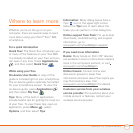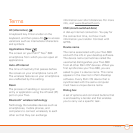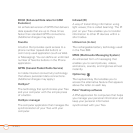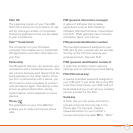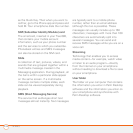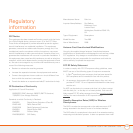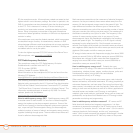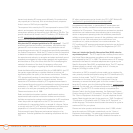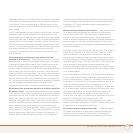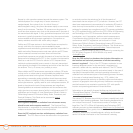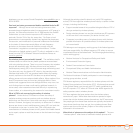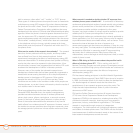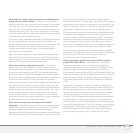
REGULATORY INFORMATION
248
RF the smartphone emits. All smartphone models are tested at their
highest value in strict laboratory settings. But when in operation, the
SAR of a smartphone can be substantially less than the level reported
to the FCC. This is because of a variety of factors including its
proximity to a base station antenna, smartphone design and other
factors. What is important to remember is that each smartphone
meets strict federal guidelines. Variations in SARs do not represent a
variation in safety.
All smartphones must meet the federal standard, which incorporates
a substantial margin of safety. As stated above, variations in SAR
values between different model smartphones do not mean variations
in safety. SAR values at or below the federal standard of 1.6 W/kg are
considered safe for use by the public.
To view the highest reported (FCC) SAR values of the Palm
®
Tre o
™
680 smartphone, visit www.palm.com/380
86.
FCC Radiofrequency Emission
This smartphone meets the FCC Radiofrequency Emission
Guidelines and is certified with the FCC as.
FCC ID number: O8F850.
Industry Canada ID number: 3905A-850
More information on the smartphone's SAR can be found from the
following FCC Website:
https://gullfoss2.fcc.gov/prod/oet/cf/eas/reports/GenericSearch.cfm
.
(The following information comes from a consumer information
Website jointly sponsored by the U.S. Food and Drug Administration
(FDA) and the Federal Communications Commission (FCC), entitled
“Cell Phone Facts: Consumer Information on Wireless Phones.” The
information reproduced herein is dated July 29, 2003. For further
updates, please visit the Website:
h
ttp://www.fda.gov/cellphones/qa.html.)
What is radiofrequency energy (RF)? Radiofrequency energy (RF)
is another name for radio waves. It is one form of electromagnetic
energy that makes up the electromagnetic spectrum. Some of the
other forms of energy in the electromagnetic spectrum are gamma
rays, x-rays and light. Electromagnetic energy (or electromagnetic
radiation) consists of waves of electric and magnetic energy moving
together (radiating) through space. The area where these waves are
found is called an electromagnetic field.
Radio waves are created due to the movement of electrical charges in
antennas. As they are created, these waves radiate away from the
antenna. All electromagnetic waves travel at the speed of light. The
major differences between the different types of waves are the
distances covered by one cycle of the wave and the number of waves
that pass a certain point during a set time period. The wavelength is
the distance covered by one cycle of a wave. The frequency is the
number of waves passing a given point in one second. For any
electromagnetic wave, the wavelength multiplied by the frequency
equals the speed of light. The frequency of an RF signal is usually
expressed in units called hertz (Hz). One Hz equals one wave per
second. One kilohertz (kHz) equals one thousand waves per second,
one megahertz (MHz) equals one million waves per second, and one
gigahertz (GHz) equals one billion waves per second.
RF energy includes waves with frequencies ranging from about 3000
waves per second (3 kHz) to 300 billion waves per second (300 GHz).
Microwaves are a subset of radio waves that have frequencies
ranging from around 300 million waves per second (300 MHz) to
three billion waves per second (3 GHz).
How is radiofrequency energy used? Probably the most
important use of RF energy is for telecommunications. Radio and TV
broadcasting, wireless phones, pagers, cordless phones, police and
fire department radios, point-to-point links and satellite
communications all rely on RF energy.
Other uses of RF energy include microwave ovens, radar, industrial
heaters and sealers, and medical treatments. RF energy, especially at
microwave frequencies, can heat water. Since most food has a high
water content, microwaves can cook food quickly. Radar relies on RF
energy to track cars and airplanes as well as for military applications.
Industrial heaters and sealers use RF energy to mold plastic
materials, glue wood products, seal leather items such as shoes and
pocketbooks, and process food. Medical uses of RF energy include
pacemaker monitoring and programming.
How is radiofrequency radiation measured? RF waves and RF
fields have both electrical and magnetic components. It is often
convenient to express the strength of the RF field in terms of each
component. For example, the unit “volts per meter” (V/m) is used to
measure the electric field strength, and the unit “amperes per
meter” (A/m) is used to express the magnetic field strength. Another
common way to characterize an RF field is by means of the power




